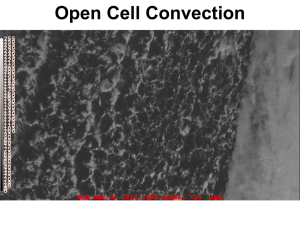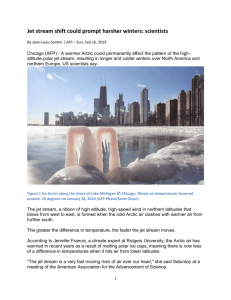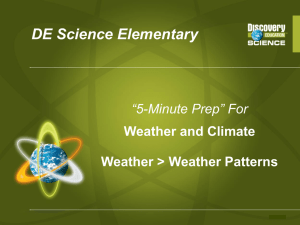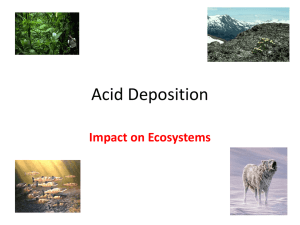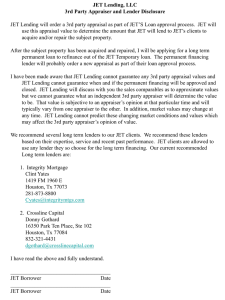Jet Streams and El Nino - Selwyn Elementary 5th Grade
advertisement
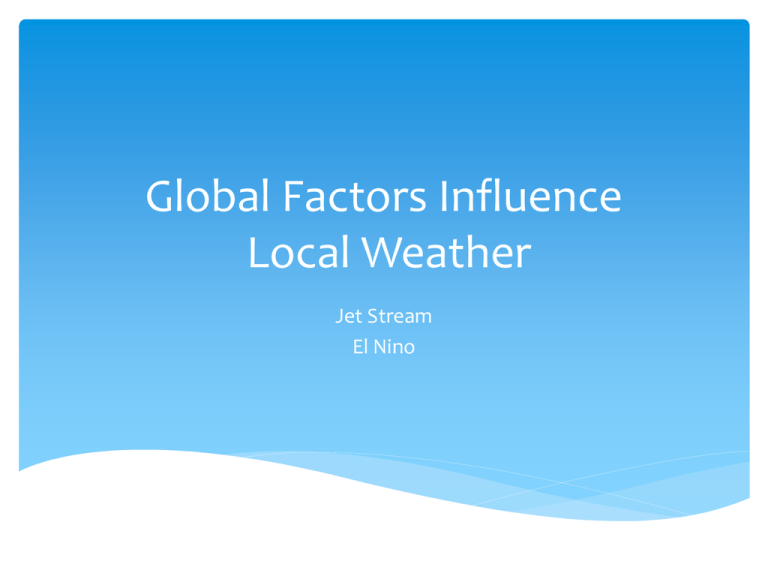
Global Factors Influence Local Weather Jet Stream El Nino Jet Stream Fast Moving (100-200 mph) river of wind Travels west to east Created by differences in temperatures of air Heated air rises and colder air rushes in and fills in the space of the rising hot air=wind Jet stream is polar (not surface) so it is affected by ALL the air below it Jet Steam on a Weather Map Jet Stream You Tube http://www.youtube.com /watch?v=CgMWwx7Cll4 Thank you DirkKCRA 3 Weather News! El Nino Change in climate in Pacific Ocean near equator Warm waters pile up in the west and slump back down to the east preventing cooler water below the surface from getting pulled up Makes for weaker winds…warmer water…weaker winds…warmer water=cycle Causes wet winters for NC and southeast US, but droughts in Indonesia and Australia El Nino Satellite Images El Nino You Tube http://www.youtube.com/ watch?v=7FVZrw7bk1w Thanks Intelecom! Student Recording Sheet for Active Viewing and Listening N a m e_ _ _ _ _ _ _ _ _ _ _ _ _ _ _ _ _ _ _ _ _ _ _ _ _ _ _ _ _ _ _ _ _ _ _ _ _ _ _ _ _ _ _ _ _ _ _ _ _ _ _ A c t ive V ie w in g - J et S t re a m S k e tc h e s : Exit TicketStudent Summation of Overview Reflection/ Formative Assessment Name________________________________________ Date __________________________ “Admit One Reward” Exit Ticket http://applepolishing.wordpress.com/reward-and-praise-but-dont-be-affraid-to-give-consequences/ Additional Resources for Further Lesson Ideas https://sites.google.com/site/elninophenomenon/process http://topex-www.jpl.nasa.gov/files/archive/make-your-own-elnino.html http://kidsahead.com/external/activity/25 http://www.ehow.com/how_5325531_understand-jetstreams.html Literacy Integration with CCSS ELA Shifts: 1) Complex Text-students grapple with informational text at or above grade level 2) Balanced Literacy-read, write, speak, and listen 3) Literacy occurs across all contents • Handout the two informational articles (on the following slide) and give Jet Stream to half the class and El Nino to the other half the class. Create home bases of 3 students and give each student one part of the article. Let them read it silently and independently (JIGSAW strategy). Record info gathered. • Let all the "experts" of that section get together and add to their notes, share, and discuss their section. Go back to home base and report. • Let home base teams create a flow map or a tree map to summarize main ideas and details of each section. Model with them if you have not already been doing this, the Frame of Reference (Thinking Maps). Have them give So What, So Why statements in red, cite the source and 2-4 in text citations as a reference in green, and point-of view (scientists, author, meteorologist) in blue. • Have them write independently off the maps (take articles away so they can not copy). Encourage them to use any info on their map in their paper. • Pairs with opposite articles present their information (record feedback on “Two Glows and a Grow” Peer Evaluation Form…free download on TPT) Informational Articles for Jigsaw Activity The Jet Stream The jet stream can best be thought of as a river of wind that moves through the Earth's troposphere. Usually going from west to east, this stream of moving air can be extremely powerful, moving on average from 100 to over 200 miles per hour. This fact was discovered during World War II when American bombers attempted to fly to Japan, but found that, due to the jet stream, the trip was nearly impossible without reconfiguring the mission parameters. Since then, aircraft pilots have learned to adjust their altitude to either fly with, or to fly below, the level of the jet stream. Wind Generally speaking, the jet stream is caused by a simple difference in temperature. More specifically, the jet stream is caused by the temperature difference in two large masses of air, and these temperatures are relatively constant geographically. Analysis begins at the Earth's surface, far below the troposphere. On the surface, wind is caused by differences in air pressure. When air in one area is heated, that air rises. This allows colder air from another area to rush in to fill the space, which causes wind. Higherpressure cold air is filling in the gap left by lower-pressure warm air as it rises into the atmosphere. Jet Stream Formation The jet stream is formed in a very similar manner to wind at the surface of the Earth. Take for instance the temperature differences between air on one side of a jet stream, the polar air from the north, and air on the other side--the warmer air above Canada and the United States. This would cause wind to form. However, since the air that forms the jet stream isn't at the surface of the Earth but up much higher, the jet stream is affected by all of the air below it. This is especially true for how hot air is rises up towards the jet stream level. This wind also moves with the turning of the Earth on its axis, which is part of what creates the high speeds of the jet stream. Unlike wind at the surface, the jet stream is at a constant, and it flows through and around areas of semi-permanent pressure differences rather than simply from a higher to a lower pressure zone. http://www.ehow.com/how-does_5565933_jet-stream-formed.html


